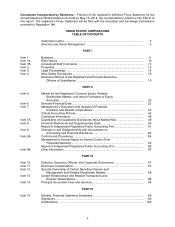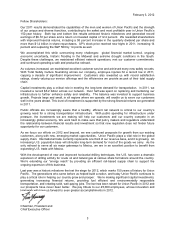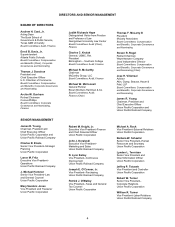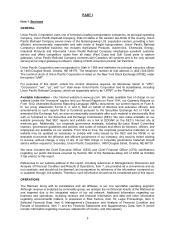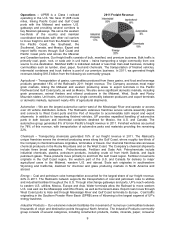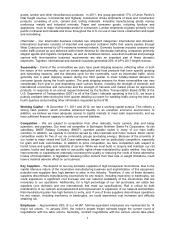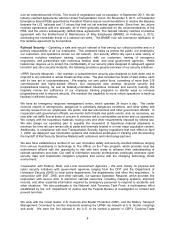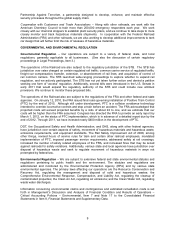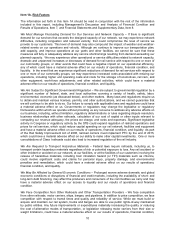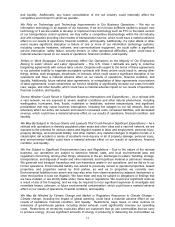Union Pacific 2011 Annual Report Download - page 8
Download and view the complete annual report
Please find page 8 of the 2011 Union Pacific annual report below. You can navigate through the pages in the report by either clicking on the pages listed below, or by using the keyword search tool below to find specific information within the annual report.8
over an extended period of time. This round of negotiations was no exception. In September 2011, the rail
industry reached agreements with the United Transportation Union. On November 5, 2011, a Presidential
Emergency Board (PEB) appointed by President Obama issued recommendations to resolve the disputes
between the U.S. railroads and 11 unions that had not yet reached agreements. Since then, ten unions
reached agreements with the railroads, all of them generally patterned on the recommendations of the
PEB, and the unions subsequently ratified these agreements. The railroad industry reached a tentative
agreement with the Brotherhood of Maintenance of Way Employees (BMWE) on February 2, 2012,
eliminating the immediate threat of a national rail strike. The BMWE now will commence ratification of
this tentative agreement by its members.
Railroad Security – Operating a safe and secure railroad is first among our critical priorities and is a
primary responsibility of all our employees. This emphasis helps us protect the public, our employees,
our customers, and operations across our rail network. Our security efforts rely upon a wide variety of
measures including employee training, cooperation with our customers, training of emergency
responders, and partnerships with numerous federal, state, and local government agencies. While
federal law requires us to protect the confidentiality of our security plans designed to safeguard against
terrorism and other security incidents, the following provides a general overview of our security initiatives.
UPRR Security Measures – We maintain a comprehensive security plan designed to both deter and to
respond to any potential or actual threats as they arise. The plan includes four levels of alert status, each
with its own set of countermeasures. We employ our own police force, consisting of more than 215
commissioned and highly-trained officers. Our employees also undergo recurrent security and
preparedness training, as well as federally-mandated hazardous materials and security training. We
regularly review the sufficiency of our employee training programs to identify ways to increase
preparedness and to improve security. We maintain the capability to move critical operations to back-up
facilities in different locations.
We have an emergency response management center, which operates 24 hours a day. The center
receives reports of emergencies, dangerous or potentially dangerous conditions, and other safety and
security issues from our employees, the public, and law enforcement and other government officials. In
cooperation with government officials, we monitor both threats and public events, and, as necessary, we
may alter rail traffic flow at times of concern to minimize risk to communities we serve and our operations.
We comply with the hazardous materials routing rules and other requirements imposed by federal law.
We also design our operating plan to expedite the movement of hazardous material shipments to
minimize the time rail cars remain idle at yards and terminals located in or near major population centers.
Additionally, in compliance with new Transportation Security Agency regulations that took effect on April
1, 2009, we deployed new information systems and instructed employees in tracking and documenting
the handoff of Rail Security Sensitive Material with customers and interchange partners.
We also have established a number of our own innovative safety and security-oriented initiatives ranging
from various investments in technology to The Officer on the Train program, which provides local law
enforcement officers with the opportunity to ride with train crews to enhance their understanding of
railroad operations and risks. Our staff of information security professionals continually assesses cyber
security risks and implements mitigation programs that evolve with the changing technology threat
environment.
Cooperation with Federal, State, and Local Government Agencies – We work closely on physical and
cyber security initiatives with government agencies ranging from the DOT and the Department of
Homeland Security (DHS) to local police departments, fire departments, and other first responders. In
conjunction with DOT, DHS, and other railroads, we sponsor Operation Respond, which provides first
responders with secure links to electronic railroad resources, including mapping systems, shipment
records, and other essential information required by emergency personnel to respond to accidents and
other situations. We also participate in the National Joint Terrorism Task Force, a multi-agency effort
established by the U.S. Department of Justice and the Federal Bureau of Investigation to combat and
prevent terrorism.
We work with the Coast Guard, U.S. Customs and Border Protection (CBP), and the Military Transport
Management Command to monitor shipments entering the UPRR rail network at U.S. border crossings
and ports. We were the first railroad in the U.S. to be named a partner in CBP’s Customs-Trade


